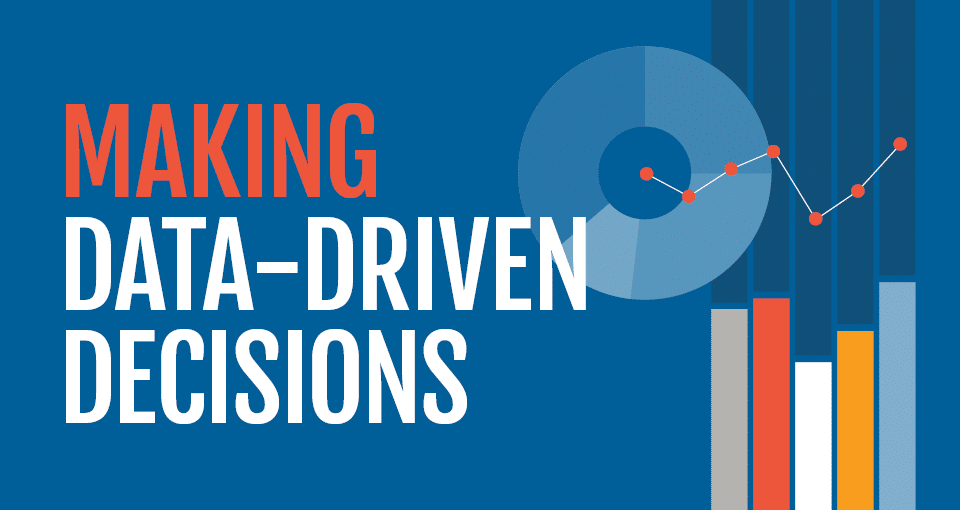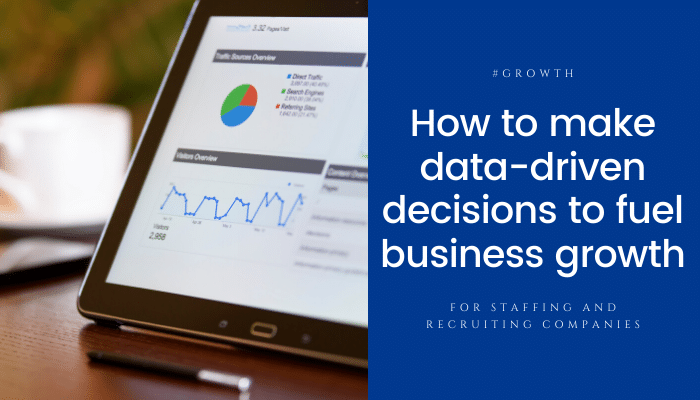What will you learn from this article:
- What is data-driven decision making?
- How can your search firm benefit from data-driven decision making?
- What decisions can you use your data for?
- Five-step plan to use your data to make smarter business decisions.
Staffing and recruiting businesses are overrun with data. Be it job openings, industry hiring trends, or candidate preferences there is more data available now than ever before.
But, for many search firms, this data just sits on sheets, ATS, or CRMs, never to be used. The good news is that instead of letting your data degrade, you can use it for your business’ growth strategy and to make better decisions.
Let us explain what data-driven decision-making is, how your search firm can benefit from using it, and a five-step process that you can use to implement a smarter business decision process.
What is data-driven decision-making?

Instead of going with a strategy you think is best, data-driven decision-making is a strategy that uses data to produce informed business decisions.
This process involves grouping your company’s historical information to analyze trends and make decisions for the future based on what’s worked in the past – rather than make decisions based on gut feelings, opinion, or experience.
The top-performing search firms position data at the core of every decision they make.
How can you benefit from data-driven decision-making?
In every business, there’s an inherent element of risk, but data-driven decisions make you less vulnerable to the decisions going wrong.
For example, imagine you’re planning a LinkedIn strategy to get more job orders. Instead of starting from scratch and hoping this strategy works, take a look at your recruiters’ historical performance data and the collective ratio comparisons. What worked? What was your “$1 LinkedIn spend to Job Orders” ratio? Replicate it or refine it. Don’t implement anything that didn’t work.
In simple words, do more of what worked and less of what may or may not work – all based on the real data of success and failures that you have collected over the years.
This is not a hypothetical logic or just wishful thinking. There are many pieces of research by credible sources that back data-driven decision making.
Businesses using big data experienced a profit increase of 8–10%, and a 10% reduction in overall cost.
If you’re still not convinced, consider this:
While 91% of companies say that data-driven decision-making is important to the growth of their business, only 57% of companies said that they base their business decisions on their data.
Data-driven decision-making is a great way to gain a competitive advantage, reduce operational costs, and increase profit.
What decisions can you use your data for?
Now you know how you can benefit from data-driven decision-making, the next step is to identify what can you use data-driven decision making for.
As a search firm, you can start by using your data for:
- Growth: What activities can you do to get more job orders and prevent client churn? Which industries can you target to get high-paying and better quality job orders?
- Marketing and sales: Which advertising channel gets the best ROI? Which sales activities generate the most job orders? Which medium is getting you the best candidate resumes and which channel should stop spending money on?
- Customer retention: How can you reduce your time-to-place? What are the top reasons for candidates declining the offers? Which channels improve candidate response times?
- Finance and Planning: What’s the most effective way to incentivize your staff? When should you start hiring new recruiters?
How to use data to make business decisions?
Now that we have the what and why of data-driven decision-making cleared out, let us get to the how.
Before you start analyzing your data or your company’s dashboard, it’s best to start with a plan of action that details how you’ll find the data you need and, more importantly, interpret the data to make the right business decisions.
Here’s a simple five-step process you can use to get started with data-driven decisions.
Step 1. Look at your objectives and prioritize
What is your objective? What are the company goals? More Job Orders? Better team communication? Improve Business Operations?
Pick the most important goal, to begin with.
For example, let’s say there is an increase in the number of job orders from the finance industry. But, you have noticed a negligible change in the total revenue while your recruiters are busy finding the right candidates and have no time to focus on getting new job orders.
Therefore, the goal is to “improve the quality of job orders from the finance industry or improve your Job Order to Billing ratio for the finance industry”. Once decided, you will need data to support it.
Step 2. Find and present relevant data
Once you have identified the problem, it’s time to find relevant data.
It’s important to stress that the word “relevant” is key here.
You don’t want to spend hours gathering and compiling data that won’t have any impact on your objective. So, keep the data relevant.
You can find relevant data in sources such as:
- Applicant Tracking Systems
- Phone System
- CRM software
- Social listening tools
- Feedback from clients and candidates
Step 3. Clean and Organize Data
Surprisingly, 80 percent of a data analyst’s time is devoted to cleaning and organizing the historical data, and only 20 percent is spent actually performing analysis.
This 80/20 difference illustrates the importance of having clean, orderly data before you can attempt to interpret what it might mean for your organization.
Cleaning the data involves preparing a raw analysis of your data, correcting data, smoothing the data to avoid data noise, and removing irrelevant and incomplete data.
Step 4. Perform Data analysis
Now that you have the clean data available, you can begin to analyze the information using different data models. At this stage, you will start to build different models that assess Job order and billing data and meet your objective. You can use different data models to analyze past trends, ratio comparisons, qualitative ratios, and quantitative ratios, team comparisons, individual AE performances, location trends, and marketing results to get a complete picture.
Take a look at the historical data you’ve collected and try to identify patterns or trends.
If we use the “improve job order quality or improve Job Order to Billing ratio” example from above, you can look at the lifetime ratios and the trend of job order values and ratios over the last few years for the finance recruiting team, you can also compare the finance recruiting team’s performance or trends with other teams to get more information.
churn rate.
Knowing in advance which data models will be effective will help you remain organized when it comes time to interpret the data.
Step 5. Draw conclusions from that data
Throughout the data analysis process, you might find information like:
- Job orders from a certain state/country have lower average job order value so you can target the states with a better outcome.
- Certain members of the team have job orders with the lower average value so you can create a custom training plan that helps them improve.
- Certain segments (for example, insurance) could have lower job order values as compared to asset management so you can align your marketing towards asset management companies.
- Certain email/ LinkedIn marketing campaigns had resulted in higher-value job orders than the others so you can replicate the higher performance campaigns.
All these can give you a concrete reason for the problem and hence providing a solution to the same.
Now compare this to a non-data-driven decision-making example.
You’d like to increase the job order value. Instead of looking at historical data, you have endless team meetings to figure out what is going on – but you end up keeping the same marketing campaigns, recruiter training material, and targeted segments and states.
A few weeks pass by and there’s no difference. You can more meetings and discussions and take another guess and guess and move on.
See the difference here?
Now imagine taking a data-driven approach for every business unit in your organization and it’s easy to see why companies that use data-driven decision-making are a lot more successful.
Now that your decision has been made, the strategy has been changed, and the results are in – well done!
But that doesn’t mean your decision-making process is over.
Look at the data you originally collected and based on your initial decision on and the outcome of the new strategy. Measure the difference, reassess the data, and continue to grow.
Conclusion:
There’s no doubt that data is a valuable tool for staffing and recruiting business.
In fact, companies that use data at the core of their decision-making reduce costs and increase profit.
The next time you need to make a decision, base it on the data you have. It could be the technique you need to fuel growth, take over your competitors, and acquire long-term, loyal customers.
In order to be a data-driven business, you need a place to collect, store, and manage your data, securely. You can do this with the data analytics tool for staffing and recruiting companies. Learn more about “the world’s only data analytics and BI tool create for search firms” by signing up for a free personalized demo.
